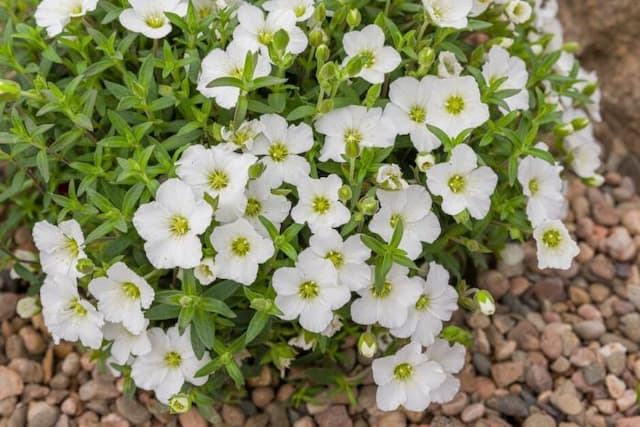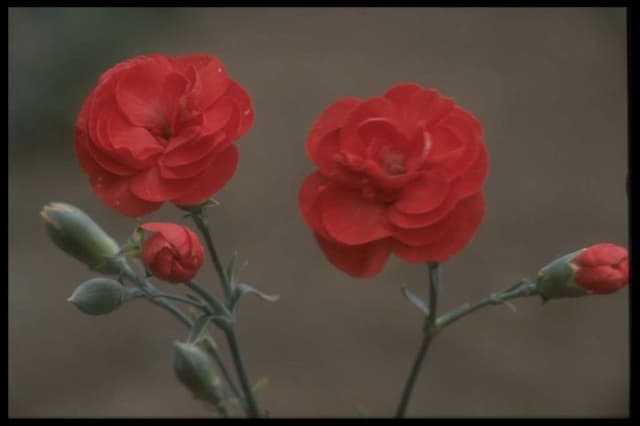Pink Dianthus 'Devon Flavia' (PBR) (Scent First Series) (p)

ABOUT
The Dianthus 'Devon Flavia' is a charming plant known for its attractive and vibrant appearance. It features a lush mound of slender, blue-green leaves that provide a striking backdrop for its flowers. The blooms are a standout characteristic, with a beautiful pink hue that ranges from soft to bright, depending on the individual flower. Each petal is finely edged, giving the flowers a frilly, delicate texture that adds to their appeal. The center of the flowers typically showcases a darker eye, creating a lovely contrast against the lighter pink petals. This particular variety is also celebrated for its delightful fragrance, which is powerful and heady, drawing in both garden admirers and pollinators alike. The blooms are carried on sturdy stems that rise just above the foliage and make excellent cut flowers for bouquets. Overall, the Dianthus 'Devon Flavia' exudes a classic cottage garden charm that can brighten up any garden space with its color and scent.
About this plant
 Names
NamesFamily
Caryophyllaceae
Synonyms
Devon Cottage Pinball Wizard, Pink, Cheddar Pink
Common names
Dianthus 'Devon Flavia' (PBR) (Scent First Series) (p)
 Toxicity
ToxicityTo humans
The plant commonly known as Pink, specifically Dianthus 'Devon Flavia', is not known to be toxic to humans. In general, Dianthus species are considered safe and do not commonly pose a threat if touched or ingested in small quantities. However, as with any plant, individuals may have allergies or sensitivities that could cause mild irritation or an allergic reaction. If large amounts are consumed, it could potentially result in gastrointestinal discomfort.
To pets
Pink, specifically Dianthus 'Devon Flavia', is also not considered toxic to pets. While the Dianthus family is generally safe for pets, ingestion of large quantities could potentially cause mild gastrointestinal upset in some animals. If a pet exhibits signs of distress after ingesting this plant, it is advisable to consult a veterinarian.
 Characteristics
CharacteristicsLife cycle
Perennials
Foliage type
Evergreen
Color of leaves
Green
Flower color
Pink
Height
1 foot (30 cm)
Spread
1 foot (30 cm)
Plant type
Herb
Hardiness zones
5
Native area
Europe
Benefits
 General Benefits
General Benefits- Attractive Flowers: Dianthus 'Devon Flavia' produces beautiful pale pink flowers with fringed petal edges that can enhance the aesthetic appeal of gardens and landscapes.
- Long Flowering Period: It typically has a long blooming season from late spring to early autumn, providing prolonged visual interest.
- Fragrance: The flowers emit a pleasant scent that can create a fragrant atmosphere in outdoor living spaces.
- Easy to Grow: It is known for being easy to care for and is suitable for gardeners of all skill levels.
- Drought Tolerance: Once established, this plant has good drought resistance, making it suitable for drier climates or water-wise gardens.
- Pest Resistance: The plant is relatively resistant to many common pests, reducing the need for chemical interventions.
- Attracts Pollinators: Dianthus 'Devon Flavia' attracts bees and butterflies, promoting pollination and benefiting the local ecosystem.
- Compact Growth: With its compact habit, it is ideal for small gardens, rockeries, borders, and containers.
- Versatility: It can be used for various purposes, including cut flowers for indoor arrangements.
- Low Maintenance: This plant generally requires minimal maintenance, which can save time and effort for the gardener.
 Medical Properties
Medical PropertiesThis plant is not used for medical purposes.
 Air-purifying Qualities
Air-purifying QualitiesThis plant is not specifically known for air purifying qualities.
 Other Uses
Other Uses- Edible Garnish - While not common, the petals of some Dianthus varieties, including those similar to 'Devon Flavia', are edible and can add a splash of color and mild spicy flavor to salads and desserts.
- Boutonnieres and Corsages - Dianthus are traditionally used by florists to create intricate boutonnieres and corsages for formal events due to their beautiful blooms and lasting nature when cut.
- Plant Dye - The brightly colored petals of Dianthus can be used to create a natural dye for fabrics, though the color may be subtle and not as bold as synthetic dyes.
- Floral Arrangements - With their long-lasting flowers and a wide range of colors, Dianthus makes a versatile addition to bouquets and other floral arrangements for various occasions.
- Aromatherapy - Dianthus 'Devon Flavia' has a scented fragrance that can be used for potpourri or to naturally freshen the air in a room when the flowers are dried and placed in a bowl.
- Camera Lens Cleaning - Petal texture of Dianthus can be used to clean sensitive optical equipment like camera lenses, as they are soft and free from scratchy fibers.
- Art and Craft Supplies - Dianthus flowers can be pressed and used for arts and crafts, such as making bookmarks, greeting cards, or decorating picture frames to create unique, personalized designs.
- Edible Cake Decorations - The flowers can be crystallized with egg whites and sugar to make beautiful and edible cake decorations for special occasions.
- Teaching Tool - Dianthus flowers are intricate and can be used in educational settings to teach botany and the anatomy of a flower, taking advantage of their easy-to-dissect nature.
- Homemade Perfume - The scent of some Dianthus varieties can be infused into oil to create a light, homemade, floral perfume.
Interesting Facts
 Feng Shui
Feng ShuiThe Pink is not used in Feng Shui practice.
 Zodiac Sign Compitability
Zodiac Sign CompitabilityThe Pink is not used in astrology practice.
 Plant Symbolism
Plant Symbolism- Diversity: The Dianthus 'Devon Flavia' comes in a variety of colors, symbolizing diversity and the rich spectrum of human experience.
- Passion: Its vibrant hues and sweet fragrance reflect deep feelings and passionate love.
- Purity: Often white or pale in color, dianthus flowers are associated with purity and innocence.
- Boldness: The striking appearance of the flower represents boldness and the courage to stand out.
- Fragrant Love: Known for its pleasant scent, it can symbolize a love that is both strong and sweet.
 Water
WaterCarnations, like the Dianthus 'Devon Flavia', prefer to be kept evenly moist, but not waterlogged. Water the plant thoroughly when the top inch of the soil feels dry to the touch, which may be once a week depending on the climate and soil drainage. Using lukewarm water, gently pour it around the base of the plant, avoiding the foliage, until it begins to drain from the bottom of the pot. On average, it might need about one gallon of water every week during the growing season, but this can vary, so adjust the amount based on rainfall and temperature conditions.
 Light
LightCarnations require full sun to thrive, meaning they should receive at least six hours of direct sunlight each day. The best spot for Dianthus 'Devon Flavia' would be a south-facing garden bed or a sunny windowsill that is not shaded by buildings or trees. Ensure a location that provides bright and unobstructed sunlight most of the day for optimal growth.
 Temperature
TemperatureCarnations, such as Dianthus 'Devon Flavia', prefer cooler temperatures and perform best in environments where the temperature ranges between 60°F and 70°F. They can tolerate temperatures as low as 40°F and as high as 85°F, but prolonged exposure outside of the ideal temperature range can stress the plant. Providing some afternoon shade during the hottest parts of the summer can help maintain the ideal temperature conditions.
 Pruning
PruningPruning carnations, such as Dianthus 'Devon Flavia', is necessary to promote bushy growth, remove dead or spent flowers, and encourage more blooms. The best time to prune is after a flush of blooming has ended. Cut back the spent flowers and any overgrown or dead stems, leaving about two-thirds of the plant intact. Pruning can be done every few weeks during the blooming season to keep the plant looking tidy and to support continuous flowering.
 Cleaning
CleaningAs needed
 Soil
SoilCarnations prefer well-draining and slightly alkaline soil with a pH between 6.7 and 7.0. A best soil mix would contain equal parts of loamy garden soil, compost, and gritty sand or perlite to ensure proper drainage and fertility.
 Repotting
RepottingCarnations, like Dianthus 'Devon Flavia', should be repotted every 1-2 years to refresh the soil and accommodate their growth, ideally in the spring before the onset of the growing season.
 Humidity & Misting
Humidity & MistingCarnations thrive in moderate humidity levels, aiming for around 40-60% is generally suitable as they do not require excessively humid conditions.
 Suitable locations
Suitable locationsIndoor
Place in bright, indirect light and ensure well-draining soil.
Outdoor
Plant in full sun, fertile soil, and protect from extreme cold.
Hardiness zone
5-9 USDA
 Life cycle
Life cycleDianthus 'Devon Flavia', commonly known as Pink 'Devon Flavia', begins its life cycle as seeds, which, when sown in fertile, well-drained soil and provided with ample sunlight, germinate to emerge as small seedlings. These seedlings then mature into robust clumps of foliage, producing narrow, green leaves. During its active growing season, typically in late spring to early summer, the plant sends up sturdy stems topped with fragrant, ruffled, pink-flowered blooms that attract pollinators. After flowering, if seed pods are allowed to develop, the plant can self-seed, continuing its life cycle. In subsequent years, the plant can be expected to grow larger and produce more flowers as it enters a phase of steady growth and blooming. To ensure vitality, Pink 'Devon Flavia' may be propagated by division every few years and should be deadheaded to encourage further blooming and prevent unwanted self-seeding.
 Propogation
PropogationPropogation time
Spring to Summer
The Dianthus 'Devon Flavia', part of the Scent First Series, is commonly propagated through cuttings. This method is popular due to its effectiveness and simplicity. The best time to take cuttings is during late spring or early summer. For propagation, choose a healthy, non-flowering shoot and cut a 3 to 4-inch (about 7.5 to 10 cm) section. The cutting should have at least two pairs of leaves. Remove the bottom pair of leaves, and dip the cut end into rooting hormone for better establishment. Then, insert the cutting into a pot filled with a mix of peat and perlite, ensuring good contact between the cutting and the medium. Maintain consistent moisture and provide indirect sunlight until roots develop, typically within a few weeks. After rooting, the new Dianthus plant can be transplanted to its final location.


![Pink [Tequila Sunrise]](/_next/image?url=https%3A%2F%2Fplants-admin.emdemapps.com%2Fimages%2Fplants%2F%2Fimages%2F604b5d995d06e.png&w=640&q=75)






